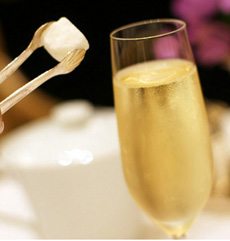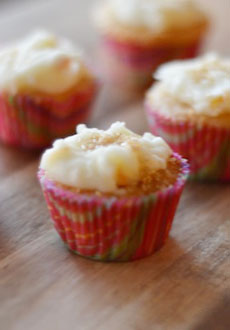3. LINE mini-cupcake tins with paper cups and pour batter evenly into each. Bake for 20-25 minutes or until golden brown.
4. MAKE the frosting. In a large bowl whip powdered sugar, butter, champagne, orange juice, and orange zest on medium speed. Spread onto cupcakes and sprinkle with colored sugar, edible glitter or dragées.
WHAT CHAMPAGNE SHOULD YOU USE?
You can use any champagne you like. The champagne is more of a “romantic” ingredient in the recipe; the cupcakes won’t taste like Dom Perignon (about $200), Roderer Cristal (about $250) or even the “bargain”-priced Veuve Clicquot Non Vintage Brut Yellow Label (about $45).
A $20 bottle will do, and a sparkling wine that isn’t from France will do. We enjoy two California sparklers made by great French champagne houses: Roederer Estate Brut, Anderson Valley and Mumm Napa Brut Prestige both about $20. Yellow Tail Rosé from Australia is just $8 and and Martini Asti Rosé from Italy is about $15 (and you can find it in splits); they work great in this recipe.
*Varietal honey comes from the particular flower named on the label: alfalfa, clover, orange blossom, etc. We know buckwheat honey and sage honey, from two different plants; but we’d never heard of a combined “buckwheat sage honey.” So we wrote to the National Honey Board and got this response from a representative:
“While I’ve never heard of “sage buckwheat” honey, it’s possible that the bees could be visiting both sage blossoms and buckwheat blossoms, gathering the nectar and bringing that back to the hive. This would result in a cross between the two floral sources and thus, a mixture in the honey. Honeybees travel in a five mile radius, so if both plants were growing the that five mile area, then I’m assuming it could be possible.
“I took a look at where each plant primarily is found. Buckwheat plants grow best in cool, moist climates. The buckwheat plant prefers light and well-drained soils, although it can thrive in highly acid, low fertility soils as well. Sage honey can come from many different species of the sage plant. Sage shrubs usually grow along the California coast and in the Sierra Nevada Mountains. So again, it could be entirely possible that they blend these honey’s together to get their ‘signature’ honey.”
|






